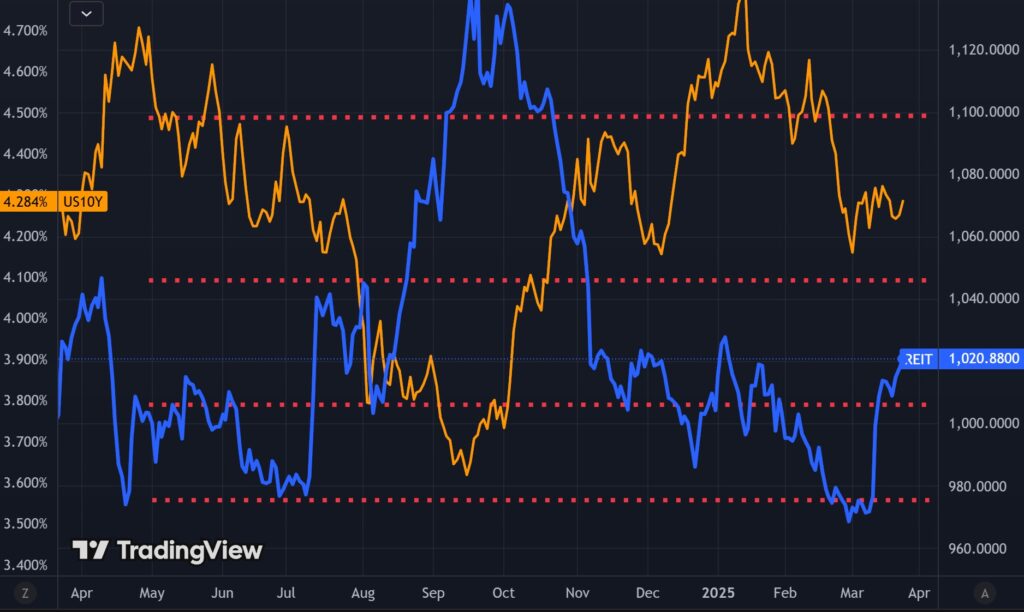iEdge S-Reit Index Weekly Review 24 Mar 25
Hi everyone,
It’s been a while since my last update. Yes, I’m still around! I usually prefer to write only when there’s something meaningful to add, and with the recent shifts in market sentiment, now feels like a good time to jump back in.
Current Sentiment
After months of sluggish performance, S-REITs have staged a surprising rally in March 2025, driven by renewed optimism over potential interest rate cuts later this year. Despite sticky inflation and a resilient U.S. economy earlier in the quarter, recent dovish signals from the Federal Reserve have shifted investor sentiment.
The 10-year U.S. Treasury yield has eased from its February highs of 4.69 percent and is now hovering closer to the 4.3 percent range, reflecting growing expectations that the Fed may initiate rate cuts by the second half of 2025. This softening in yields has restored some appeal to yield-sensitive sectors like REITs, particularly those with more defensive or industrial exposure such as Ascendas REIT, Mapletree Industrial Trust, and Keppel DC REIT
Analysts attribute the rebound to a combination of bargain hunting, stabilizing global yields, and clearer guidance from central banks suggesting that the rate hike cycle is over.
While borrowing costs remain elevated compared to the ultra-low rate era, the relative outlook is improving. Investors are starting to reprice REITs with a more benign rate environment in mind, especially for those with strong balance sheets and resilient tenant demand.

S-REITs Chart Analysis
The chart above suggests that, in recent months, the iEdge S-REIT Index (in blue) and the US 10-Year Treasury Yield (in orange) have not followed their usual inverse correlation. As the yield dips below 4.5 percent, the S-REIT Index has also declined.
Whether this signals a shift in relationship or just a temporary blip, it’s a reminder to stay agile and keep watching for new signals.
Singapore Overnight Rate Average (SORA) Chart
The Singapore Overnight Rate Average (SORA) is the volume-weighted average rate of borrowing transactions in the unsecured overnight interbank SGD cash market in Singapore between 8 a.m. and 6.15 p.m.
SORA is important for S-REITs because it directly influences their financing costs. Many S-REITs have floating-rate loans that are pegged to SORA, meaning their interest expenses rise or fall depending on how SORA moves. When SORA is high, it erodes distribution per unit (DPU), as more rental income gets eaten up by interest payments. Conversely, a falling SORA can improve profitability and DPU, especially for REITs with significant exposure to short-term or variable-rate debt.
As a result, SORA is a key metric to watch, especially in a climate where interest rate direction is still uncertain.
We can see that SORA has been gradually declining from its highs in 2023 and 2024, recently dipping to around 2 percent.
Why Is This Happening?
This is likely because MAS hasn’t tightened policy further, and with inflation more stable now, there’s less need to keep borrowing costs elevated. The interbank market is also seeing improved liquidity, unlike the tighter conditions we saw in late 2023 when short-term funding costs were under more pressure.
Looking Ahead
With SORA gradually easing and market sentiment shifting toward potential rate cuts later this year, the pressure on S-REITs has started to lift. The recent rebound in the iEdge S-REIT Index reflects this improving backdrop, but it’s not a green light to go all in.
While lower interest rates may eventually support valuations, not all REITs will benefit equally. Rising operating costs, uneven tenant demand, and refinancing risks still loom large for some sectors. This is where selectivity matters.
Rather than chasing the highest yields, I believe it’s more important to focus on REITs with resilient fundamentals. Those backed by stable, recurring income and prudent balance sheet management.
Defensive segments like necessity-driven retail and essential infrastructure remain my key focus, such as Frasers Centrepoint Trust and NetLink NBN Trust (a business trust), which are anchored in essential services and everyday demand.
That said, let’s be honest. No one can predict the future with certainty. Interest rates could spike again. Sentiment can shift overnight. That’s why staying adaptable, focused on quality, and managing risk matters more than ever.
Stay patient, stay selective, and prioritise strength over noise.

Found this article useful? Share it and let us all have free coffee from dividends!
